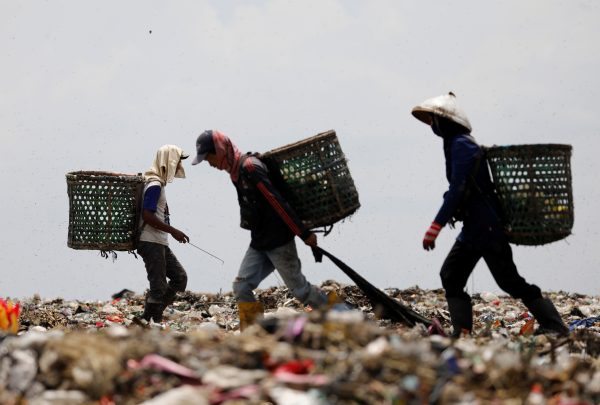The social assistance programs are mainly continuations from the previous government. Recipients of the Indonesian Smart Card for Education (KIP) — some 19.7 million students in 2016 — receive Rp 450,000 (US$32) per year for elementary school, Rp 750,000 (US$54) for junior high school and Rp 1 million (US$72) for senior high school. And under the Indonesian Health Card (KIS) program, which reached over 90 million people in 2017, the government pays a premium of Rp 23,000 (US$2) per person each month.
The government also furthered the Subsidised Rice for the Poor (Rastra) program, where each household is entitled to buy 10–20 kilograms of rice per month at a heavily subsidised price of Rp 1600 (US$0.1) per kilogram (compared to the market price of around Rp 12,000 (US$0.9) per kilogram). This program reached 15.8 million households in 2017.
With the aim of reducing the impact of a fuel price hike at the end of 2014, the Jokowi government implemented an Unconditional Cash Transfer (BLSM) program to the amount of Rp 1 million (US$72) per household for eight months. In 2017, this program covered 15.8 million households. In comparison, the Conditional Cash Transfers (PKH) program provides benefits of around Rp 1.9 million (approximately US$136) per household each year. The Jokowi government substantially expanded the coverage of this program from 2.8 million households in 2014 to 10 million households in 2018.
Despite these expansions, Indonesia still spends considerably less on social assistance compared to other countries at a similar level of development. Social assistance spending in Indonesia is about 0.7 per cent of GDP, which is less than a half of the average for lower middle income countries (1.5 per cent of GDP).
Meanwhile, the Village Fund came into effect in the 2015 budget year. The use of Village Fund grants is determined by villagers at a forum, which is then formally proposed in an expenditure plan. Most villages have allocated over 70 per cent of their funds for infrastructure development, especially the improvement of village roads. Only a small amount of money has been allocated for community empowerment programs, such as livelihood skills training and facilitation.
Under the Village Fund scheme, the government provided a block grant of Rp 280 million (US$20,000) to each rural village in 2015, which grew to Rp 800 million (US$57,000) as of 2018. Consequently, the Village Fund’s overall budget increased from Rp 20 trillion (US$1.4 billion) in 2015 to Rp 60 trillion (US$4.3 billion) in 2018.
One might expect Jokowi’s social policy initiatives to contribute to pro-poor economic growth by addressing the problems of stagnating poverty reduction and high inequality. Yet upon examining the impact of economic growth on the consumption growth of various segments of Indonesia’s population, the middle class reveals itself as the largest beneficiary of Jokowi’s poverty and inequality reduction schemes.
Across the first three years of the Jokowi administration (2014–17) and former president Susilo Bambang Yudhoyono’s administration (2004–14), consumption per capita of all segments of Indonesia’s population continuously increased. But the trends in growth rates for different segments of the population varied between the two presidents’ tenures.
Under Yudhoyono, consumption growth of the rich was higher than that of other segments of the population, leading to an increase in inequality during those periods. In contrast, in the first three years of Jokowi’s administration it was the middle class who experienced the highest growth compared to both the poor and the rich, which explains the decrease in inequality in Indonesia in recent years.
Even though inequality has decreased, the poor have been comparatively excluded from economic growth under Jokowi. Under Yudhoyono, the consumption of the poorest 20 per cent of the population grew at the same rate as economic growth. But during the first three years of Jokowi’s administration, it grew at a rate less than economic growth — indicating that the poor are now less connected to economic growth.
For the middle class (the second and third quintiles of the wealth distribution), their consumption growth was only half of economic growth under Yudhoyono during his second term and has increased to become comparable to rates of economic growth under Jokowi. Since 2004, the consumption of the richest 20 per cent of Indonesia’s population has consistently grown at a rate higher than economic growth.
The challenge for the Jokowi administration is to make Indonesian economic growth more inclusive, especially for its poorest population. Despite Jokowi’s social policy initiatives, it is the middle class who are reaping most of the benefits of economic growth. To connect the poor to economic growth, the government’s social assistance policies need to be complemented by job creation and income generation strategies for the poor.
Asep Suryahadi is Director of the SMERU Research Institute.
Ridho Al Izzati is a Junior Researcher at the SMERU Research Institute.

